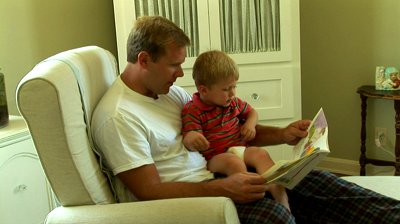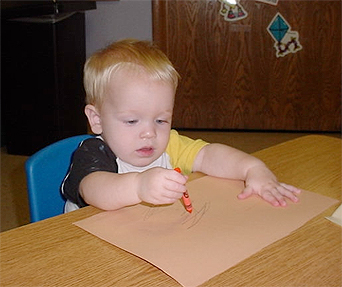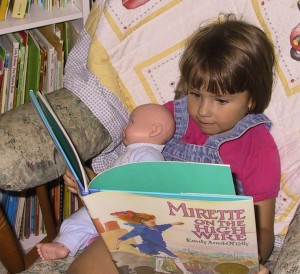Children mature incredibly quickly between birth and third grade. The following lists are normal skills and behaviors to look for in kids at various stages early in life, some of which relate to the Five Essential Components of Reading. Use these to get an idea of how your child's learning is progressing or to spot areas in which you may need to spend more time.
At 6 to 12 months, most babies should be able to:
 Hold their heads steady and sit in your lap without support
Hold their heads steady and sit in your lap without support- Grasp books and put them in their mouth
- Drop and throw books
- Pat pictures to show interest
- Play along in games such as peek-a-boo and pat-a-cake
- Make cooing and babbling sounds
- Associate some of the words they hear frequently with their meanings
- Respond to their name
- Say simple words such as "ma", "ba", or "da"
At 12 to 24 months, most babies/toddlers should be able to:
 Hold and walk with books
Hold and walk with books- No longer put the book in their mouth right away
- Turn board book pages and play with alphabet blocks
- Recognize certain books by their covers
- Turn books right-side-up and understand how they should be handled
- Give books to adults to read
- Point at pictures and name some of them
- Follow simple stories
- Share books with an adult as a routine part of life
- Say single words, then two to four word phrases
- Pay attention to rhymes in songs and enjoy nonsense word games with parents or caregivers
- Identify sounds different animals make
- Have a common vocabulary of 200 words (16-24 months)
- Add 10-20 new words per day to their vocabulary (18-24 months)
Most children age 2 to 3 should be able to:
 Turn paper pages two to three at a time
Turn paper pages two to three at a time- Pretend to read books
- Share books with an adult as a routine part of life
- Enjoy the same book again and again
- Name familiar objects
- Complete sentences in rhymes and familiar stories
- Pay attention to specific print, such as the first letters of their names
- Start to scribble
- Have a vocabulary of 1000 words (32-39 months)
- Add two to four new words per day to their vocabulary
At age 3 to 4, most children should be able to:
 Turn pages one at a time and from left to right
Turn pages one at a time and from left to right- Sit still for longer stories
- Pretend to read to dolls or stuffed animals
- Enjoy listening to and talking about storybooks
- Understand that print carries a message
- Recite whole phrases from books
- Remember nursery rhymes and play rhyming games
- Identify some letters and make some letter-sound matches (Phonics)
- Identify familiar signs and labels
- Get information/directions from conversations or books that are read aloud to them
- Scribble and Draw
At age 5 (Kindergarten), most children should be able to:
 Sound as if they are reading when they pretend to read
Sound as if they are reading when they pretend to read- Enjoy being read to
- Retell simple stories
- Recite 6-10 nursery rhymes
- Understand some print concepts (reading moves left to right and top to bottom, meaning comes from words, book has a front cover and pages, stories have a beginning, middle, and end)
- Recognize and know the names and sounds of at least 12-15 upper and lower case letters (Phonics)
- Begin to match spoken words with written ones (Phonics)
- Show familiarity with rhyming and beginning sounds (Phonemic Awareness)
- Play and enjoy simple word games in which two or more words start with the same sound. For example, "Name all the animals you can think of that start with the letter D" (Phonemic Awareness)
- Understand that spoken words can be broken down into smaller parts, such as the word "big" in "bigger" (Phonemic Awareness)
- Understand that they can change a small part of word and make a different word. For example, change the first sound of the word "cat" and you can get hat, rat, sat, and bat (Phonemic Awareness)
- Speak in complete sentences
- Use descriptive language to explain or ask questions
- Print their first name using upper and lower case letters
- Begin to name and write letters and numbers that they see in books or on signs
At age 6, most children should be able to:
 Read and retell familiar stories (Fluency/Reading Comprehension)
Read and retell familiar stories (Fluency/Reading Comprehension)- Use a variety of ways to help with reading a story such as rereading, predicting what will happen, asking questions, or using visual cues or pictures (Reading Comprehension)
- Read some things aloud with ease (Fluency)
- Identify new words by using letter-sound matches, parts of words, and their understanding of the rest of a story or printed item (Phonics, Phonemic Awareness, Vocabulary, Reading Comprehension)
- Identify an increasing number of words by sight (Vocabulary)
- Understand that you can change a small part of word and make a different word. For example, change the first sound of the word "cat" and you can get hat, rat, sat, and bat. (Phonemic Awareness)
- Sound out and represent major sounds in a word when trying to spell
- Decide on their own to use reading and writing for different purposes
Sources:
Reading Foundation
Parenting Counts
NAEYC
Reading Begins
Reach Out and Read
 Hold their heads steady and sit in your lap without support
Hold their heads steady and sit in your lap without support Hold and walk with books
Hold and walk with books Turn paper pages two to three at a time
Turn paper pages two to three at a time Turn pages one at a time and from left to right
Turn pages one at a time and from left to right Sound as if they are reading when they pretend to read
Sound as if they are reading when they pretend to read Read and retell familiar stories (Fluency/Reading Comprehension)
Read and retell familiar stories (Fluency/Reading Comprehension)